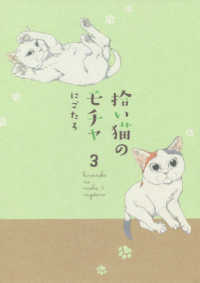Full Description
This book adopts a corpus-based discourse analysis approach to the study of the communicative practices of pick-up artists, offering a systematic exploration of distinct language use in an online community that uses speed-seduction practices for short-term dating and sex. Drawing on a multi-million-word corpus comprising data from online forums, social media, informational websites, and YouTube videos, the volume explores the verbal practices and narrative framing techniques that pick-up artists (PUAs) draw upon in their interactions with women and the terminology-heavy language used in teaching pick-up to foster perceptions of scientific validity. The book also unpacks videos and reports of live interactions to study naturally occurring PUA discourse from different perspectives but also to more closely examine conceptual metaphors of competition and violence and critically reflect on the ethical considerations of working with such communities. This book will appeal to students and scholars in such disciplines as discourse analysis, corpus linguistics, computer-mediated communication, and language and media, as well as those interested in the study of language use online.
Contents
Acknowledgments
1 Introduction
1.1 Introduction
1.2 Pick-up artists: Who are they?
1.3 Why study pick-up artists?
1.4 Can words seduce?
1.5 Which tools to use?
1.5.1 Corpus compilation
1.5.2 Corpus annotation
1.5.3 Corpus analysis
1.6 Why discourse analysis?
1.7 Overview of the book
1.7.1 Chapter 2: Pick-up artists and the seduction industry
1.7.2 Chapter 3: Lexical aspects of pick-up artist discourse
1.7.3 Chapter 4: The pragmatics of pick-up artist interactions
1.7.4 Chapter 5: Conversations in the field
1.7.5 Chapter 6: Teaching and selling seduction
1.7.6 Chapter 7: Conclusion
1.7.7 Chapter 8: The PUA glossary
2 Pick-up artists and the seduction industry
2.1 Introduction
2.2 Rise and fall of the pick-up artist
2.2.1 PUAs and negative publicity
2.2.2 PUAs in the press
2.3 Speed seduction: Industry or community?
2.3.1 The seduction industry
2.3.2 Seduction community
2.4 PUA genres
2.4.1 Dimensions of genre variation in the PUA community
2.4.2 Offline genres: In-fields
2.4.3 Offline genres: Guru lectures
2.4.4 Online genres: Guru how-to videos
2.4.5 Online genres: Social media
2.4.6 Online genres: Field reports on forums
2.4.7 Online genres: Websites and newsletters
2.5 Conclusion
3 Lexical aspects of pick-up artist discourse
3.1 Introduction
3.2 Data and methodology
3.2.1 The Field Reports + Replies Corpus
3.2.2 The e-PUA Corpus
3.2.3 Semantic tagging
3.3 Making it look like science: Pseudo-scientific vocabulary
3.4 Lexical markers of pick-up belonging: Keyword analysis
3.5 Where does it come from: Pick-up word-formation
3.5.1 Semantic Shift
3.5.2 Compounding and zero derivation
3.5.3 Acronyms and abbreviations
3.6 The numbers' game: Quantification in pick-up discourse
3.7 Hashtags for friends: Technological affordances for affiliation
3.8 Conclusion
4 The pragmatics of pick-up artist interactions
4.1 Introduction
4.2 Field reports as a PUA genre: A refresher
4.3 Invoking expectations through frames
4.4 Never a fail, always a success
4.4.1 The schema: PUA field report
4.4.2 The frame: Success or failure
4.5 Confidence building through self-praise
4.5.1 The self-praise iceberg
4.5.2 Types of self-praise in field reports
4.6 Conclusion
5 Conversations in the field
5.1 Introduction
5.2 What are in-fields?
5.3 Power imbalance in seduction encounters
5.3.1 A quantitative approach to analysing power in talk
5.3.2 Power in talk: Topic control
5.3.3 Modal verbs
5.4 Macro-analysis of pick-up artists' seduction techniques
5.4.1 Pick-up models
5.4.2 Understanding in-fields with the help of conversation analysis
5.4.3 The Daygame Blueprint and preference organisation
5.4.4 Discursive moves in the Capture Phase: Model vs. reality
5.5 Conclusion
6 Teaching and selling seduction
6.1 Introduction
6.2 Data and methodology
6.2.1 The PUA-Lecture Corpus
6.2.2 The PUA-How-To Corpus
6.3 The instructional nature of the videos
6.4 Becoming and being a PUA guru
6.4.1 Creating an expert identity
6.4.2 Information-related strategies
6.4.3 Experience-related strategies
6.4.4 Identity-related strategies
6.4.5 Interaction-related strategies
6.4.6 Expert identity strategies in PUA-How-To
6.5 Comparing PUA-Lecture and PUA-How-To: Guru evolution
6.6 Conclusion
7 Conclusion
7.1 Pick-up artists: A language-based view
7.1.1 Language is a part of the shared repertoire and a constitutive element of the PUA community
7.1.2 The persuasive intent of PUA discourse is aimed at other PUAs
7.1.3 Prioritising engagement over liking
7.1.4 Representation does not match reality
7.2 Seduction as persuasive talk
7.3 Is it just words?
7.4 Concluding remarks
Appendix A: Transcription conventions
Appendix B: Lists of videos included in PUA-Lecture and PUA-How-To
Glossary of pick-up artist terms
References
Index








